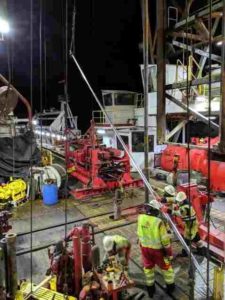
An ocean drilling ship is not an ocean drilling ship without the skilled and experienced personnel that control, execute and overview the drilling operations. The JOIDES Resolution is no exception.
Of the 123 souls currently onboard, about 30 people facilitate the success and safety of all ocean drilling operations—about the same number as scientists onboard. Among them are five drillers, two tool pushers, six floormen and two derrickmen. While drillers control the advance of the drill pipe and the motion of the core barrel within the drill pipe from a control booth, tool pushers oversee the operations and maintain equipment and tools. Floormen and derrickmen perform all actions on the rig floor, from putting the drill pipe together and sending the core barrel down the drill pipe to the sea floor, to eventually pulling a sediment-laden core out of the core barrel. Most of the drill crew have decades of experience.
Drilling ocean sediments for scientific purposes is not simply achieved by forcing a steel rod into the sea floor and hoping for the best recovery. It actually involves building a multi-piece drill bit (called the bottom-hole assembly) that cuts into the seabed, as well as carefully maneuvering and documenting the location of the drill bit near and below the seafloor, and adjusting the drilling tools according to the stiffness and composition of the material. Most importantly, seafloor drilling requires facilitating safe drilling operations, in particular for those right in the center of action on the JOIDES Resolution rig floor, our floormen.
As a sedimentologist onboard, I primarily work in the core laboratory. On the live feed monitors of the core laboratory, we can watch the drill team work on the rig floor. It is winter in the Southern Ocean at the moment, so it is mostly windy or rainy outside, or in fact both. Sometimes this makes me feel a little bit like I am in a golden tower in the core lab, far away from all the danger, grease, and noise of the drill floor. However, this does not diminish my respect and gratitude towards the drill crew and their work, as the quality of the drilled sediments they recover often governs the quality and impact of our scientific results. This particularly struck me when I had the chance to climb up the derrick of the JOIDES Resolution, six weeks into our expedition.
The top of the derrick ascends 65 meters (over 200 feet!) above the sea level, and is used to raise the drill pipe to a vertical position from the hull of the ship, in order to lower it to the sea floor. If you want to be at the highest point of the derrick (called the “crown”), you have to trust your arms, legs and your fall protection device to bring you all the way to the top of the drill rig. I thank Wouter, our Dutch driller, who talked me through the process of how to wear the required six-pound harness, how to use the safety carabiners, and how to change my fall protection system at each of the six wet and greasy ladders.
In order to drill ocean sediments, the drill pipe must first be extended to the seafloor, which requires lowering the pipes through the water column. This is done by adding 30-meter segments of drill pipe (a “stand”) on top of each other using the winch system of the derrick—a process that is called “tripping pipe.” Depending on the water depth of our study site, this usually takes several hours. I, as an impatient person, always have to remind myself that, for the length of a stand of 30m relative to the mean ocean depth of 4,000m (~2.5 miles), a few hours of tripping pipe is actually very fast. For an equivalent scale using the 10cm derrick of our paper model JOIDES Resolution, below, the whole sedimentology team onboard must stand next to each other to mimic the average depth of the ocean and the distance over which we have to trip the pipe.
Tripping pipe only brings us to the bottom of the ocean, but not into the sea floor. Drill tools need to be lowered through the drill pipe in order to recover seabed samples, 4,000 meters below the ship. For marine sediments, this is done through Advanced Piston Coring (APC) or Half-APC, where a piston assembly with an empty core liner is lowered by wireline through the drill pipe. At the chosen depth, the “firing depth,” the driller increases the hydraulic pressure on the core barrel, which allows the piston to suddenly, but in a controlled manner, penetrate 10 meters (APC) or 5 meters (Half-APC) into the sediments below. This firing process fills up the plastic core liner with precious ocean mud samples. This cycle repeats after the core barrel is raised to the rig floor through the wireline, and the outer drill pipe advances 10 meters further into the sea floor.
Ocean drilling is easier said than done. It is fascinating at the same time how technology and the expertise of our drilling and operations team come together to retrieve a mostly undisturbed and continuous climate archive from a far away place and time. I cannot thank them enough for their work as they are a crucial part in the long process of unveiling the inner workings and mechanisms that govern our Earth system.
Note: The above post is reprinted from materials provided by Earth Institute, Columbia University .










